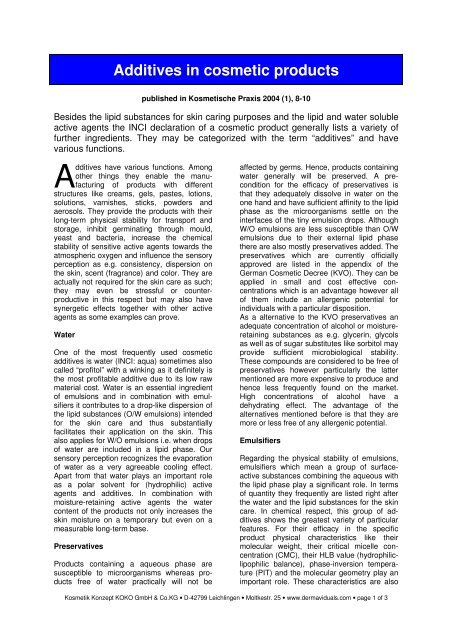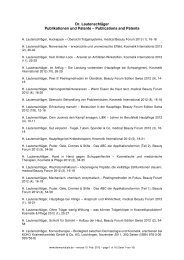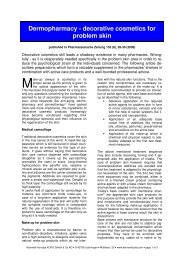Additives in cosmetic products - Dermaviduals
Additives in cosmetic products - Dermaviduals
Additives in cosmetic products - Dermaviduals
You also want an ePaper? Increase the reach of your titles
YUMPU automatically turns print PDFs into web optimized ePapers that Google loves.
<strong>Additives</strong> <strong>in</strong> <strong>cosmetic</strong> <strong>products</strong><br />
published <strong>in</strong> Kosmetische Praxis 2004 (1), 8-10<br />
Besides the lipid substances for sk<strong>in</strong> car<strong>in</strong>g purposes and the lipid and water soluble<br />
active agents the INCI declaration of a <strong>cosmetic</strong> product generally lists a variety of<br />
further <strong>in</strong>gredients. They may be categorized with the term “additives” and have<br />
various functions.<br />
A<br />
dditives have various functions. Among<br />
other th<strong>in</strong>gs they enable the manufactur<strong>in</strong>g<br />
of <strong>products</strong> with different<br />
structures like creams, gels, pastes, lotions,<br />
solutions, varnishes, sticks, powders and<br />
aerosols. They provide the <strong>products</strong> with their<br />
long-term physical stability for transport and<br />
storage, <strong>in</strong>hibit germ<strong>in</strong>at<strong>in</strong>g through mould,<br />
yeast and bacteria, <strong>in</strong>crease the chemical<br />
stability of sensitive active agents towards the<br />
atmospheric oxygen and <strong>in</strong>fluence the sensory<br />
perception as e.g. consistency, dispersion on<br />
the sk<strong>in</strong>, scent (fragrance) and color. They are<br />
actually not required for the sk<strong>in</strong> care as such;<br />
they may even be stressful or counterproductive<br />
<strong>in</strong> this respect but may also have<br />
synergetic effects together with other active<br />
agents as some examples can prove.<br />
Water<br />
One of the most frequently used <strong>cosmetic</strong><br />
additives is water (INCI: aqua) sometimes also<br />
called “profitol” with a w<strong>in</strong>k<strong>in</strong>g as it def<strong>in</strong>itely is<br />
the most profitable additive due to its low raw<br />
material cost. Water is an essential <strong>in</strong>gredient<br />
of emulsions and <strong>in</strong> comb<strong>in</strong>ation with emulsifiers<br />
it contributes to a drop-like dispersion of<br />
the lipid substances (O/W emulsions) <strong>in</strong>tended<br />
for the sk<strong>in</strong> care and thus substantially<br />
facilitates their application on the sk<strong>in</strong>. This<br />
also applies for W/O emulsions i.e. when drops<br />
of water are <strong>in</strong>cluded <strong>in</strong> a lipid phase. Our<br />
sensory perception recognizes the evaporation<br />
of water as a very agreeable cool<strong>in</strong>g effect.<br />
Apart from that water plays an important role<br />
as a polar solvent for (hydrophilic) active<br />
agents and additives. In comb<strong>in</strong>ation with<br />
moisture-reta<strong>in</strong><strong>in</strong>g active agents the water<br />
content of the <strong>products</strong> not only <strong>in</strong>creases the<br />
sk<strong>in</strong> moisture on a temporary but even on a<br />
measurable long-term base.<br />
Preservatives<br />
Products conta<strong>in</strong><strong>in</strong>g a aqueous phase are<br />
susceptible to microorganisms whereas <strong>products</strong><br />
free of water practically will not be<br />
affected by germs. Hence, <strong>products</strong> conta<strong>in</strong><strong>in</strong>g<br />
water generally will be preserved. A precondition<br />
for the efficacy of preservatives is<br />
that they adequately dissolve <strong>in</strong> water on the<br />
one hand and have sufficient aff<strong>in</strong>ity to the lipid<br />
phase as the microorganisms settle on the<br />
<strong>in</strong>terfaces of the t<strong>in</strong>y emulsion drops. Although<br />
W/O emulsions are less susceptible than O/W<br />
emulsions due to their external lipid phase<br />
there are also mostly preservatives added. The<br />
preservatives which are currently officially<br />
approved are listed <strong>in</strong> the appendix of the<br />
German Cosmetic Decree (KVO). They can be<br />
applied <strong>in</strong> small and cost effective concentrations<br />
which is an advantage however all<br />
of them <strong>in</strong>clude an allergenic potential for<br />
<strong>in</strong>dividuals with a particular disposition.<br />
As a alternative to the KVO preservatives an<br />
adequate concentration of alcohol or moisturereta<strong>in</strong><strong>in</strong>g<br />
substances as e.g. glycer<strong>in</strong>, glycols<br />
as well as of sugar substitutes like sorbitol may<br />
provide sufficient microbiological stability.<br />
These compounds are considered to be free of<br />
preservatives however particularly the latter<br />
mentioned are more expensive to produce and<br />
hence less frequently found on the market.<br />
High concentrations of alcohol have a<br />
dehydrat<strong>in</strong>g effect. The advantage of the<br />
alternatives mentioned before is that they are<br />
more or less free of any allergenic potential.<br />
Emulsifiers<br />
Regard<strong>in</strong>g the physical stability of emulsions,<br />
emulsifiers which mean a group of surfaceactive<br />
substances comb<strong>in</strong><strong>in</strong>g the aqueous with<br />
the lipid phase play a significant role. In terms<br />
of quantity they frequently are listed right after<br />
the water and the lipid substances for the sk<strong>in</strong><br />
care. In chemical respect, this group of additives<br />
shows the greatest variety of particular<br />
features. For their efficacy <strong>in</strong> the specific<br />
product physical characteristics like their<br />
molecular weight, their critical micelle concentration<br />
(CMC), their HLB value (hydrophiliclipophilic<br />
balance), phase-<strong>in</strong>version temperature<br />
(PIT) and the molecular geometry play an<br />
important role. These characteristics are also<br />
Kosmetik Konzept KOKO GmbH & Co.KG • D-42799 Leichl<strong>in</strong>gen • Moltkestr. 25 • www.dermaviduals.com • page 1 of 3
<strong>Additives</strong> <strong>in</strong> <strong>cosmetic</strong> <strong>products</strong> page 2 of 3<br />
important to evaluate their tolerance on the<br />
sk<strong>in</strong>: the lower the molecular weight and the<br />
higher the critical micelle concentration, the<br />
higher the probability for irritat<strong>in</strong>g side effects<br />
for sensitive sk<strong>in</strong>. This also applies for surfaceactive<br />
agents which are closely related to<br />
emulsifiers and used <strong>in</strong> cleans<strong>in</strong>g <strong>products</strong>.<br />
Most of the emulsifiers currently used will not<br />
modify after their penetration <strong>in</strong>to the sk<strong>in</strong> i.e.<br />
they will not <strong>in</strong>tegrate <strong>in</strong>to the physiology of the<br />
sk<strong>in</strong>. Particularly the use of O/W emulsifiers<br />
consequently will cause the emulsifiers to<br />
reactivate <strong>in</strong> the sk<strong>in</strong> after contact with water<br />
and this even with <strong>in</strong>creased effects when<br />
cleans<strong>in</strong>g the sk<strong>in</strong>. This gradually will lead to a<br />
loss of the natural lipid substances of the sk<strong>in</strong>.<br />
In case of a long-term application of creams<br />
with a specific composition, the consumer will<br />
have the impression that his sk<strong>in</strong> obviously is<br />
becom<strong>in</strong>g dehydrated.<br />
An alternative to conventional emulsifiers are<br />
natural membrane-form<strong>in</strong>g substances like<br />
ceramide and phosphatidylchol<strong>in</strong>e. They form<br />
layered lamellar structures <strong>in</strong> the creams<br />
similar to the barrier layers of the sk<strong>in</strong>, are free<br />
of the above mentioned side effects and<br />
perfectly <strong>in</strong>tegrate <strong>in</strong>to the physiology of the<br />
sk<strong>in</strong>. A disadvantage are higher manufactur<strong>in</strong>g<br />
costs compared to conventional <strong>products</strong><br />
however it should be kept <strong>in</strong> m<strong>in</strong>d that they<br />
provide an excellent comb<strong>in</strong>ation of the<br />
positive features of additives and active<br />
agents. (For further details see KOSME-<br />
TISCHE PRAXIS 5/2003).<br />
Antioxidants<br />
The group of antioxidants also simultaneously<br />
provides a comb<strong>in</strong>ation of additive and active<br />
agent properties. Thus, the vitam<strong>in</strong>s C and E<br />
as well as their derivates protect the sensitive<br />
<strong>in</strong>gredients of <strong>cosmetic</strong> <strong>products</strong> aga<strong>in</strong>st the<br />
atmospheric oxygen and free radicals; on the<br />
other hand they provide the sk<strong>in</strong> with specific<br />
effects. By contrast synthetically produced<br />
phenolic antioxidants as e.g. butylated<br />
hydroxytoluene (INCI: BHT) only have to be<br />
classified as additives.<br />
As already small traces of some of the heavy<br />
metals cause the natural substances which are<br />
sensitive to oxidation to become rancid by their<br />
radical-form<strong>in</strong>g effect, together with the antioxidants<br />
additional complex<strong>in</strong>g agents based<br />
on ethylendiam<strong>in</strong>etetraacetic acid (EDTA),<br />
citric acid and salts of the phosphonic acid are<br />
comb<strong>in</strong>ed. Traces of heavy metals which get<br />
<strong>in</strong>to the product after open<strong>in</strong>g the jar will thus<br />
be <strong>in</strong>activated.<br />
Substances controll<strong>in</strong>g the consistency<br />
Besides emulsifiers which also <strong>in</strong>fluence the<br />
consistency of <strong>products</strong> apart from their<br />
specific functions, additional additives are used<br />
to control the consistency of formulations.<br />
These can be thicken<strong>in</strong>g agents like e.g.<br />
xanthan, carrageenan, alg<strong>in</strong>ate or chemically<br />
modified cellulose compounds. They form gellike<br />
structures which solidify the aqueous<br />
solutions and emulsions proportionately to<br />
their concentration.<br />
Due to the easily reproducible properties of<br />
synthetic polymers polyacrylates have ga<strong>in</strong>ed<br />
acceptance and can be recognized <strong>in</strong> the INCI<br />
by the term sodium carbomer. After<br />
penetration of the cream they virtually rema<strong>in</strong><br />
<strong>in</strong>different on the surface of the sk<strong>in</strong>.<br />
Polyacrylates may be modified to provide<br />
thixotropic or quick break features which<br />
means that they liquefy after spread<strong>in</strong>g or after<br />
contact with the sk<strong>in</strong>.<br />
Substances controll<strong>in</strong>g the consistency which<br />
are based on sugar-like structures as e.g.<br />
xanthan <strong>in</strong>fluence the sk<strong>in</strong> hydration as they<br />
have water-reta<strong>in</strong><strong>in</strong>g features. Simultaneously<br />
the <strong>in</strong>visible film which forms on the surface of<br />
the sk<strong>in</strong> decreases the transepidermal water<br />
loss. Also the muc<strong>in</strong>s of aloe show a similar<br />
behavior. Thus there is no clear divid<strong>in</strong>g l<strong>in</strong>e<br />
between additives and active agents.<br />
Closely connected to the consistency is the<br />
spreadability of the product on the sk<strong>in</strong>. For<br />
this purpose, frequently additives with specific<br />
spread<strong>in</strong>g properties are used. These are<br />
substances which more or less automatically<br />
spread on the sk<strong>in</strong> as e.g. synthetic esters like<br />
isopropyl myristate (IPM) or diisopropyl<br />
adipate. The advantage of an easily spread<strong>in</strong>g<br />
product however can also be counterproductive<br />
as e.g. <strong>in</strong> areas like the mucous<br />
membranes of the eye which should be left<br />
untouched as irritations may result.<br />
Perfumes <strong>in</strong> <strong>cosmetic</strong> <strong>products</strong>: improved<br />
<strong>in</strong>gredient-label<strong>in</strong>g<br />
For the sensory acceptance of a product the<br />
perfume or scent of the preparation has proved<br />
to be of specific importance. The scent of a<br />
product f<strong>in</strong>ally is composed of a multitude of<br />
different chemical compounds which are<br />
impossible to specifically declare. Predom<strong>in</strong>antly<br />
low-molecular compounds can be found<br />
which easily penetrate <strong>in</strong>to the sk<strong>in</strong>. Therefore<br />
it is no surprise that perfume oils head the list<br />
of the number one allergenic substances. For<br />
the sensitive sk<strong>in</strong> dermatologists hence<br />
recommend <strong>products</strong> which are free of<br />
perfumes.<br />
Kosmetik Konzept KOKO GmbH & Co.KG • D-42799 Leichl<strong>in</strong>gen • Moltkestr. 25 • www.dermaviduals.com • page 2 of 3
<strong>Additives</strong> <strong>in</strong> <strong>cosmetic</strong> <strong>products</strong> page 3 of 3<br />
On the packag<strong>in</strong>g so far the aromatic pr<strong>in</strong>ciples<br />
<strong>in</strong> perfumes just have been labeled with<br />
the term “perfume”. This however is not very<br />
helpful for the identification of the different<br />
components of perfume oils. The publication of<br />
a modified European <strong>cosmetic</strong> legislation <strong>in</strong><br />
March 2003 changed the rout<strong>in</strong>e applied so<br />
far. In the appendix for the guidel<strong>in</strong>es, 26<br />
aromatic substances are listed which are more<br />
frequently associated with allergenic reactions<br />
than all the rest of them. If the agreed<br />
concentration is exceeded there has to be an<br />
<strong>in</strong>dication regard<strong>in</strong>g the percentage conta<strong>in</strong>ed<br />
on the pack<strong>in</strong>g of the <strong>cosmetic</strong> product us<strong>in</strong>g<br />
the INCI terms as e.g. anise alcohol, benzyl<br />
alcohol, coumar<strong>in</strong>, eugenol, hydroxycitronellal,<br />
limonene and geraniol.<br />
The leaflet "Klarheit für e<strong>in</strong> ungetrübtes<br />
Duftvergnügen“ which provides <strong>in</strong>formation on<br />
perfumes can be ordered free of charge at the<br />
follow<strong>in</strong>g address: Industrieverband Körperpflege-<br />
und Waschmittel e.V. (IKW), Karlstraße<br />
21, 60329 Frankfurt am Ma<strong>in</strong>, Tel. +49-69-<br />
25561323, e-mail: <strong>in</strong>fo@ikw.org, www.ikw.org<br />
Dyes and pigments<br />
This group of substances also comprises many<br />
different substances. Pigments sometimes are<br />
used to lighten creams and pastes and thus<br />
<strong>in</strong>fluence the optical acceptance. In the field of<br />
decorative <strong>cosmetic</strong>s pigments are used for<br />
the sk<strong>in</strong> color<strong>in</strong>g and thus actually are not part<br />
of the additives <strong>in</strong> the narrower sense. This<br />
also applies for camouflage <strong>products</strong> which<br />
predom<strong>in</strong>antly have a cover<strong>in</strong>g function.<br />
Anorganic pigments and their product mixtures<br />
are widely used and examples here are titan<br />
dioxide and iron oxide. Organic dyes also are<br />
applied <strong>in</strong> this field. Due to their <strong>in</strong>solubility<br />
they stay on the surface of the sk<strong>in</strong> and will be<br />
r<strong>in</strong>sed off with the cleans<strong>in</strong>g.<br />
Anorganic pigments like titan dioxide and z<strong>in</strong>c<br />
oxide also provide UV filter features. Therefore<br />
<strong>in</strong> sun protection <strong>products</strong> they have an active<br />
agent <strong>in</strong>stead of additive function.<br />
Dr. Hans Lautenschläger<br />
Kosmetik Konzept KOKO GmbH & Co.KG • D-42799 Leichl<strong>in</strong>gen • Moltkestr. 25 • www.dermaviduals.com • page 3 of 3




